How To Promote A Free Wordpress Blog
Writing high-quality content is only a small part of creating and maintaining a successful blog. To further increase site traffic and attract more readers to your site, you'll need to work on blog promotion.
Luckily, there are plenty of strategies that are cost-effective and easy to implement.
Read on to discover how to promote your blog effectively in ten different ways – start experimenting with any of these solutions and watch the traffic roll into your site.
- These are the best blogging platforms on the market

1. Utilize SEO for your blog
Before learning how to promote your blog, the first step you should take is optimizing your site for search engines. With good SEO, it will be much easier for a blog to rank high on search engine result pages (SERPs) and attract more traffic.
Many factors impact a site's SEO performance, including the website platform and hosting service you choose to create a blog. These two aspects determine the overall consistency of the site experience you offer to visitors.
When choosing a platform to build a blog, consider starting with a content management system (CMS). This tool makes it easy for non-technical users to create and manage a website. It also offers complete control over a site's design, functionality, and SEO.
One of the best CMSs to get started with is WordPress. It comes built-in with many SEO features, including meta descriptions, a customizable URL structure, and the ability to use page titles.
Keep in mind that there are two different versions of WordPress – Wordpress.com and WordPress.org. Although both platforms provide the same quality of SEO performance, the latter gives users more freedom to utilize plugins to further improve their SEO.
Make sure to also pick a web hosting service that's reliable, fast, and secure. Some of the top hosting providers to consider are:
Hostinger – has excellent performance and comes with an SEO toolkit to evaluate technical SEO issues on a website. Their hosting prices start at $1.39/month.
Bluehost – offers several SEO tools to increase site traffic. The cost of starting a WordPress blog with their shared hosting plans startsfrom $3.95/month.
HostGator – provides great uptime and speed. The fee of creating a blog with this web host's shared hosting solutions starting at $2.75/month.
Aside from choosing the right platform and hosting service, there are other blog SEO practices to keep in mind in order to increase blog traffic:
- Choose a mobile-friendly theme - Mobile page load speed is a key metric that Google uses when determining a site's search ranking. That's why it's crucial to make a blog responsive to any device.
- Internal linking - Internal links can boost a blog's traffic since they help Google understand and rank the site better. Internal linking also allows visitors to navigate a blog easily.
- Use a CDN provider - A content delivery network (CDN) can boost the speed and reduce the resource usage of a website.
- Link out to other sites - Including links to some high-quality and authoritative websites can help search engine crawlers understand what a post is about.
- Compress images - Reducing the file size of blog posts' images can speed up a site and improve page loading times.
To manage and monitor your blog's search engine rankings, make sure to use the best SEO tools for the job, such as SEMRush or Ahrefs.
Additionally, take advantage of free Google SEO tools such as Google Analytics to see the in-depth breakdown of your blog traffic, helping you identify how well your SEO efforts are working.
- We've rounded up the best onpage SEO tools for your website
2. Do proper keyword research
Knowing the important keywords to use on your blog posts can also improve the blog's ranking on SERPs and generate valuable traffic. These terms can be discovered by doing keyword research.
Keyword research helps bloggers to create content their visitors are searching for. This process also reveals how many people are searching for a specific keyword and how high the competition is.
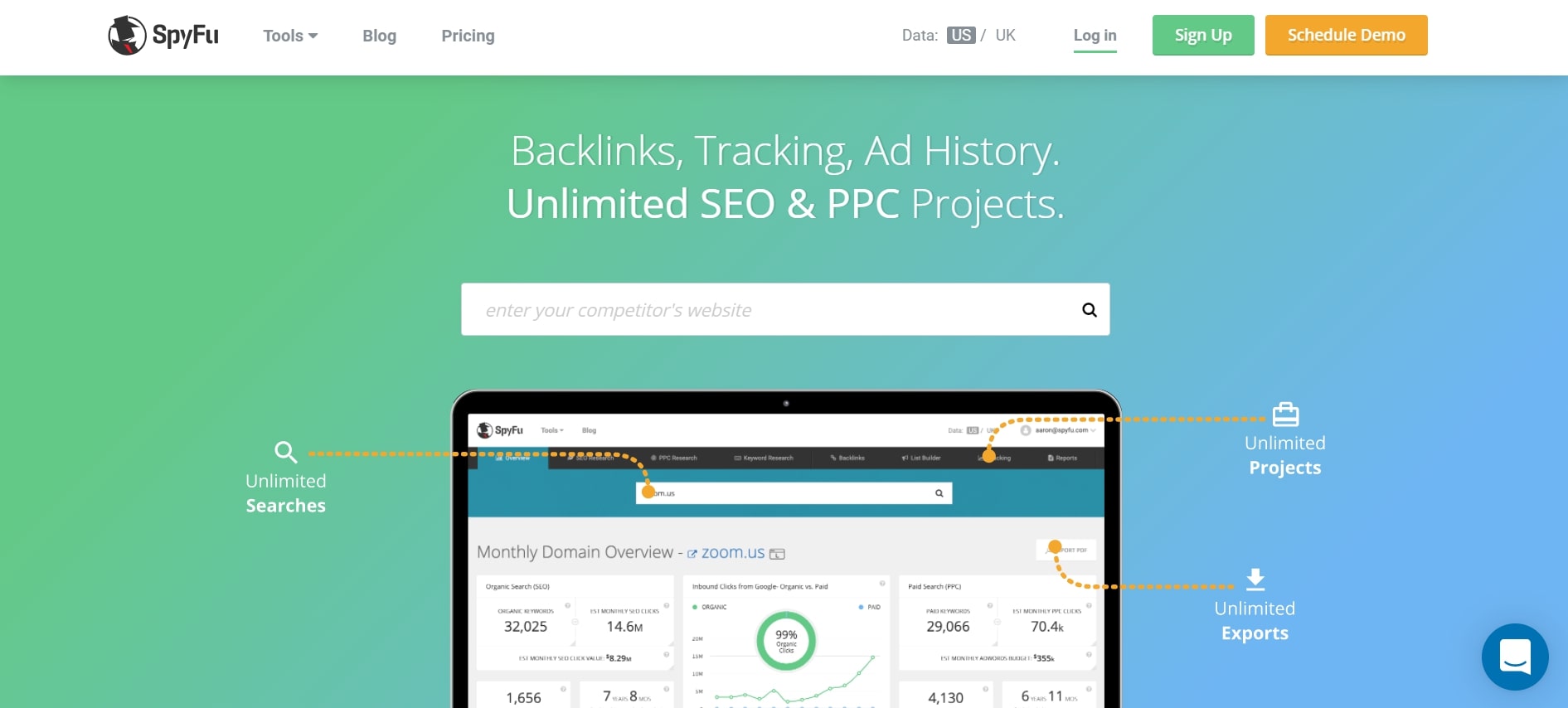
There are plenty of keyword research tools such as KWFinder and SpyFu that can be used to discover keywords, common questions, and topics for content.
When doing keyword research, consider these aspects to decide the best keywords for your blog:
Searcher's intent - This refers to website users' intention when searching Google for a specific term. To attract qualified traffic, be sure to choose keywords that match your target audience's user intent.
Search volume - A keyword's search volume shows how competitive the term is. Try to target keywords with great search volume since they can increase a blog's chance to generate significant organic traffic. Keep in mind, however, that it requires more effort to rank for terms with high search volume.
Traffic potential - To identify the keyword's traffic potential of a topic, use tools like Ahrefs and see how much traffic the current top-ranking pages get and what other keywords they rank for. This process can help you prioritize your keywords and find related terms that users are searching for.
Keyword difficulty - Many SEO analytics tools provide this metric to show how difficult it is to rank for a specific keyword. The higher the score of the term, the more competitive it is.

Once you have a list of terms to rank for, it's time to use them for on-page SEO. Here are some key places on a blog to use these keywords:
Page titles - A blog page title is the first element of a site page that people notice in the SERPs. Make sure to use a target keyword at the start of the page title to have both Google and your audience recognize the main subject of the page.
Subheadings - The purpose of subheadings is to make content scannable. Using target keywords in subheadings can increase a content's relevance for the readers.
Content - It's one of the most important search ranking factors. Thus, try to include keywords naturally throughout the content and avoid keyword stuffing.
URLs - Using a clean URL with a keyword can improve a site's architecture, make a blog easier to navigate, and help it rank higher in relevant search results.
Meta descriptions - A meta description is a short explanation that shows up on SERPs under the page title. To boost a page's click-through rate, try to create a compelling description using target keywords.
Images - Always use alt text for pictures to help search engine crawlers understand your images. Additionally, alt text is vital to a blog's accessibility since it allows visually impaired users better understand an on-page image.
Remember to use Google Search Console to track your current keyword positioning and analyze which pages drive traffic to your blog.

3. Use email marketing
Email marketing can be one of the most effective ways of promoting your blog and converting visitors if done correctly. This blog promotion strategy helps you notify readers of new blog posts or share any good news with ease.
Sending personalized messages to blog visitors can also help create meaningful relationships with them, keep the audience hooked with high-quality content, and boost engagement on a blog.
The first step to take before getting started with email marketing is to build an email list, a collection of email addresses used to send promotional material.
Here are a few ways to build an email list:
Offer an incentive - Consider giving readers an incentive like a free course, eBook, or cheat sheet in exchange for their email address.
Collect emails directly from the blog - Create a signup form and place it on your home page. Make it stand out and attract readers' attention with a strong and compelling call to action (CTA).
Create content upgrades - A content upgrade is a valuable offer that complements an article that the reader is already interested in, created to get a visitor's email address.
Once you have a mailing list, look for email marketing software like Constant Contact or MailChimp. Using an email marketing tool makes it easier to create attractive email templates, deliver emails to large groups of contacts, track messages, and view analytics.
The next step is to craft email content that can lead visitors back to your blog. Here are some tips on how to promote your blog with the use of effective promotional emails:
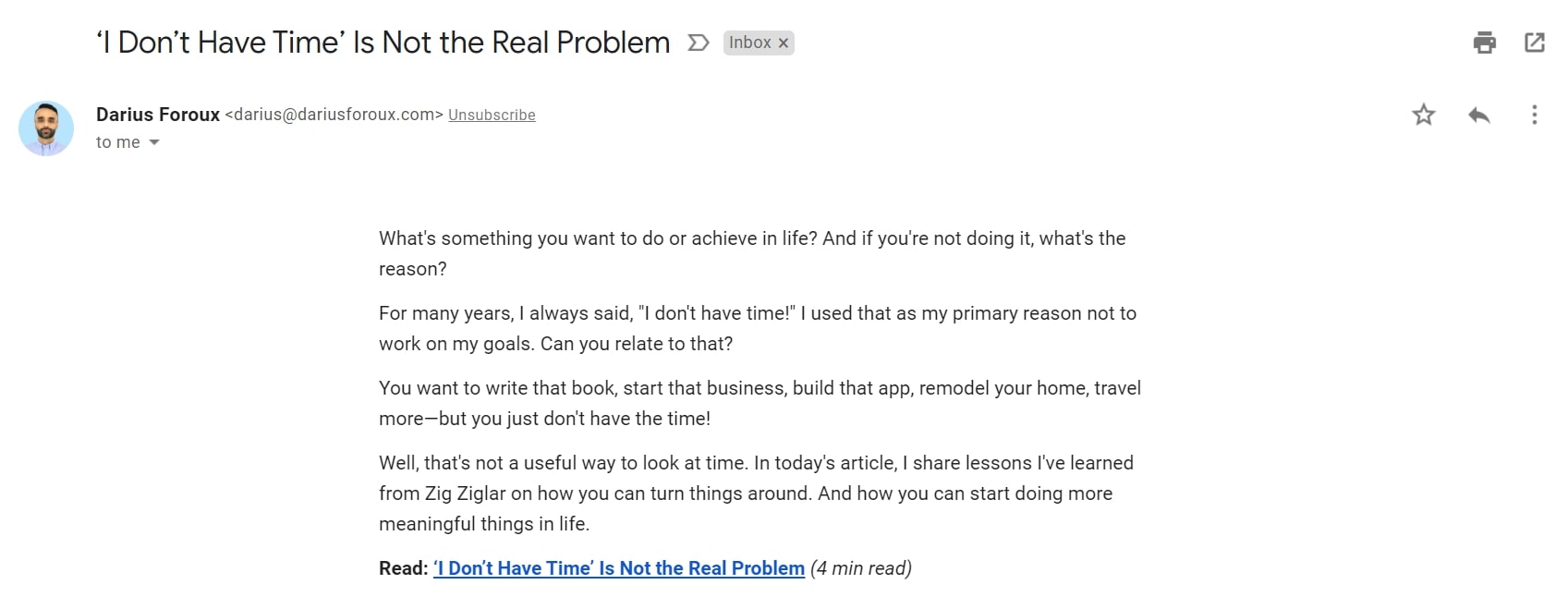
Provide valuable insight for readers - Use your email to convince readers that your blog post can solve their problems. This email newsletter from Darius Foroux is a great example:
Highlight the content value in the email subject - Readers might receive dozens of promotions every day, so try to capture their attention by creating a short, compelling email subject that clearly states the value of your content.
Create personalized subject lines - Including recipient names in the email's subject can lead to a 21.2 percent open rate. It can also make the subscribers feel like the email is crafted specifically for them, which helps to build relationships and establish trust.
Make it easy to read - Keep the email clean and easy to digest by using appealing pictures and paragraph breaks.
Use links - Avoid adding attachments to a message since it can affect email deliverability, making it more likely to get lost in spam filters. Instead, use call-to-action links to grab subscriber's attention and encourage them to act.
Proofreading - To make your emails look more professional, be sure to check for any grammar errors before sending them out.
- Also check out our roundup of the best email services

To get more exposure quickly and efficiently, try sharing your blog post on popular social networks such as Facebook, Instagram, or Pinterest.
Here are some of the benefits of using social media sites to promote your blog:
Increase blog traffic - Sharing content on different social networks helps bloggers reach a wider audience. Additionally, if the content provides value to the users, they might share it further and recommend it to others.
Cost-effective - With social media channels, bloggers can make their site visible to a targeted audience for free.
Improve engagement with the audience - A blogger can also have a personal and meaningful conversation with their readers through social networks. Devoting time to communicate with the audience will help to build trust.
Social media platforms aren't all created the same, so try to focus on the most relevant social networks that suit your target audience. For instance, if you're targeting female readers, then Pinterest might be the right social media for you.
Here are other tips for leveraging social media and bringing more traffic to your blog:
- Add a blog link to the bio - A social media bio is the first thing people see on an account. Make sure to use it to drive traffic to your site or blog content.
- Share engaging content using existing posts - Use a free tool like Canva to convert your top blog articles into appealing graphics.
- Integrate social media icons into the site - Adding social media icons to a blog makes it easier for visitors to share blog content with their audience.
- Post regularly - Be sure to know how often you should share in a specific social network. For example, Twitter users should share at least one tweet a day.
- Use hashtags - Utilizing a hashtag is a great way to expand the reach of a post and connect it to a specific conversation, topic, or event. Hashtags also make it easier to locate other relevant content around particular terms.
- Join online groups - Become part of a social community such as the ones found in LinkedIn, or a Facebook group to share content and increase the visibility of your blog.
- Find the optimal time for posting - Knowing the optimum time to post on your chosen channel can help you get more clicks and engagements. Thankfully, most social platforms have an analytics or insights tool that provides this information. Once you know the best times to post, start planning and preparing your content in advance using social media management tools like Buffer.
Remember that social media is a two-way engagement platform that requires actual interaction. Don't just reappear whenever you have a new blog post – instead, maintain a regular presence on a social network by starting conversations, responding to comments, and answering questions.
5. Promote your blog with online paid advertising
If you have a budget you're willing to spend, consider using online paid advertising to promote your blog content. This strategy refers to a marketing method where you pay for ad spots to attract internet traffic.
With the paid promotion, your page can appear right in front of your target audience in no time. It's also possible to see the results as soon as your ads go live.
Online paid marketing can feature one or more digital channels, including search engine results pages (SERPs) and social media platforms.
The process of increasing blog visibility on SERPs through paid advertising is usually known as search engine marketing (SEM). This method relies on keywords to target users when they're performing searches in a search engine.
Here's an example of how advertisements appear for the keywords "how to boost your SEO":
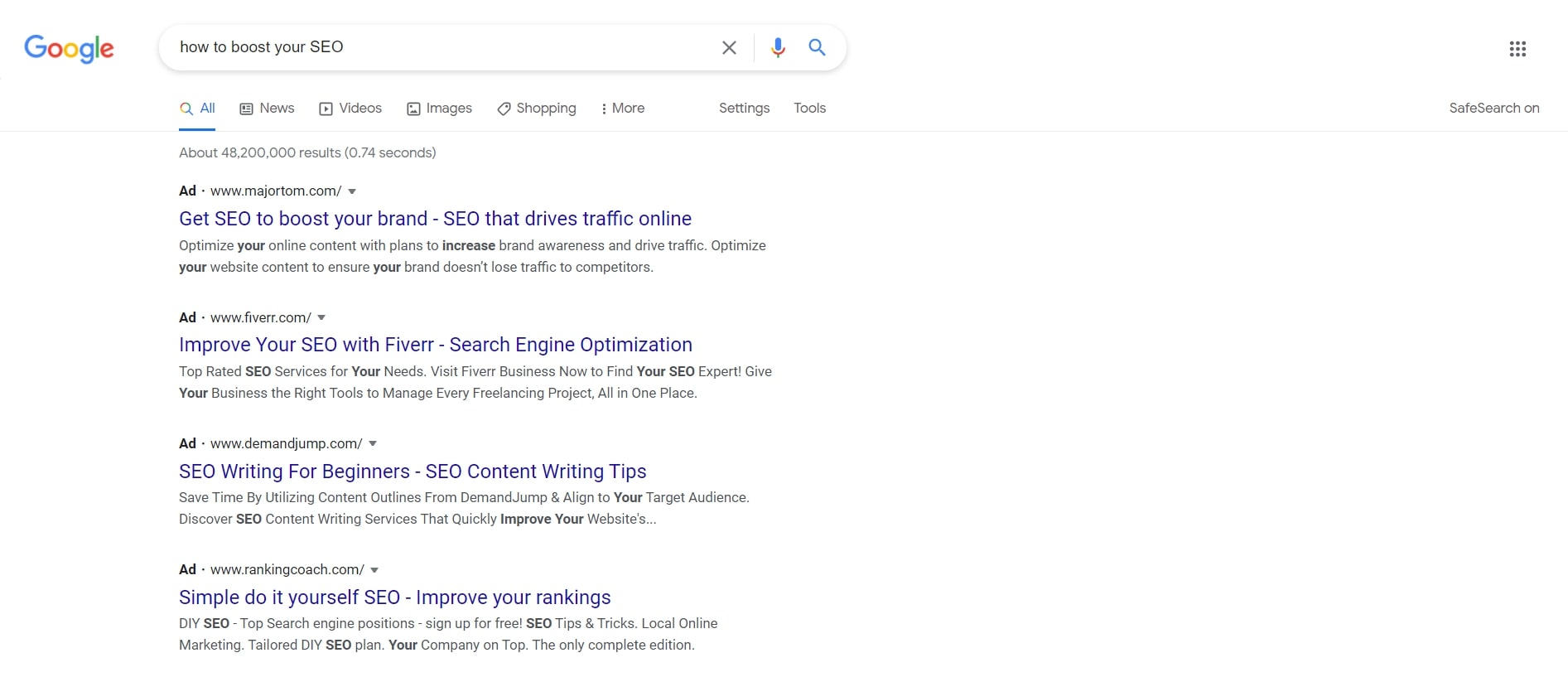
To promote a blog with search advertising, try using a popular online marketing service like Google Ads.
Also, consider the following suggestions before getting started with paid search ads:
Be clear on budget and expectations - Make sure to have a specific budget to avoid overspending and clear goals in order to analyze whether a campaign works or not.
Keep the quality score up - A quality score rates the relevance of both your ads and keywords. Having a great quality score can help to keep your ad costs low.
Bid on competitive blog keywords - If your competitors have a lot of traffic for their brand name, try to target those keywords with your ads. This way, searchers will see your relevant content and go to your blog post instead of those of the competitors.
Another form of paid advertising is social media ads. This blog promotion method lets you target users based on their locations, specific interests, and buying behaviors.
Some of the best social media sites for advertising are Facebook, Instagram, LinkedIn, and Twitter.
Here are a few tips on how to promote your blog with social media advertising:
- Design the ads with mobile in mind - Since 91 percent of users access social channels via mobile devices, ensure your ads incorporate easy-to-view images on the small screen.
- Use videos - A video is more engaging and has a better return on investment (ROI) than other media types.
- Test your ads - Try A/B testing your ads to see what works best for your campaign and make the most of your spending.

6. Guest post on popular blogs
Guest posting on other blogs is an excellent way to promote your blog since it lets you expose your brand to other bloggers' loyal audiences. This method also helps to establish yourself as an authority figure and connect with other thought leaders in a niche.

To find guest blogging opportunities, go to blog directories like AllTop, Bloglovin, and OnTopList. These websites can help people discover relevant blogs in a niche that might accept guest posting.
Once you have a list of potential blogs to guest post on, use a backlink analysis tool like Moz to check the domain authority for each of the sites you're considering – the higher a blog's domain authority, the easier it can rank in search engines. Doing this also showcases whether these sites provide good value in terms of links.
Keep the following tips and tricks in mind to get started with guest blogging:
Form a genuine relationship with the site owners - Many website owners only take guest content from bloggers they already know and trust. Thus, try to connect with them first before sending a pitch by subscribing to their newsletter, leaving comments on their blog posts, and commenting on their social content.
Keep the pitch short and straight to the point - Since most site owners don't have the time to read long emails, keep your email as brief and direct as possible.
Link to your blog articles - Some sites might let guest bloggers backlink to their site, helping to drive referral traffic and lead to better search visibility for the blog. Bloggers can use Google Analytics to track traffic from this guest posting effort.
Ask the audience to leave comments - Encourage readers to post their opinions and share the content. This helps to have the content rank for different keywords that are naturally mentioned in the comments.
Take advantage of the author's profile - Guest bloggers can also include their blog's link in the author's bio, which helps to drive people to their site.
7. Reach out to other bloggers
Another viable blog promotion solution is the conduction of blogger outreach. It's a marketing strategy that involves getting the help of well-known bloggers or influencers to improve a blog's exposure by offering something in return, such as a fee, backlink, product, or service.
With this blog promotion method, new bloggers can acquire high-quality backlinks, attract quality traffic, and expand their network.

To get started with blogger outreach, look for influencers in your niche using tools like GroupHigh, Influencity, and Lumanu.
Then, refer to these tips on how to promote your blog by leveraging the loyal audience of others:
- Get the influencers to notice you - Mention influencers on social media and promote their relevant content to make them recognize you.
- Interview professionals - Aside from asking for an inbound link from influencers, bloggers can also invite them for an interview. When the interview is published, the influencers might also share it with their audiences.
- Try broken link building - A great tip to get backlinks from influencers without paying a dime is to identify broken links on their blogs and present your content as an alternative replacement.
- Track the results - Use a backlink checker like Majestic to see which influencers are giving you the best coverage and the most leads.
- Cultivate relationships - After getting blog coverage from an influencer, make sure to maintain your relationship with them. The stronger the relationship, the longer the benefits can last for your blog.
A social bookmarking site is a platform to read and save a specific web page or article. With this tool, users can access their bookmarks from any device at any time.
Social bookmarking sites are great places to share blog posts with new readers. When your content is listed on or shared through a bookmarking site, it can result in massive increases in traffic back to your blog.
To begin with this blog promotion method, bloggers need to choose a platform to participate in and submit their content to that site. Some of the most popular bookmarking websites are Digg, Flipboard, and Pocket.

Bloggers can also share their blog posts on niche social bookmarking sites like GrowthHackers and DZone to generate more relevant shares and traffic.
Here are a few tips on how to promote your blog content on a social bookmarking site:
Make the headlines count - Some social bookmarking platforms might only display the article's title. Thus, compel potential readers to click on your link by using a catchy, captivating headline.
Add a featured image - Make the article stand out on the news feeds by using attractive graphics.
Keep the description length in mind - Some sites might limit the description space to 150 characters, so try to make the description short and match the content.
Utilize social bookmarking buttons on the blog - Consider adding a social bookmarking button on your site to let readers bookmark content with ease.
9. Promote your blog in online forums
Another excellent method of blog promotion is to join online forums. Being part of online communities lets you interact, contribute, and bring value to a niche group of people.
Joining online forums also allows bloggers to share their knowledge, which can help establish their expertise in a field.
However, finding niche forums can be overwhelming, especially in some of the biggest online communities like Reddit.
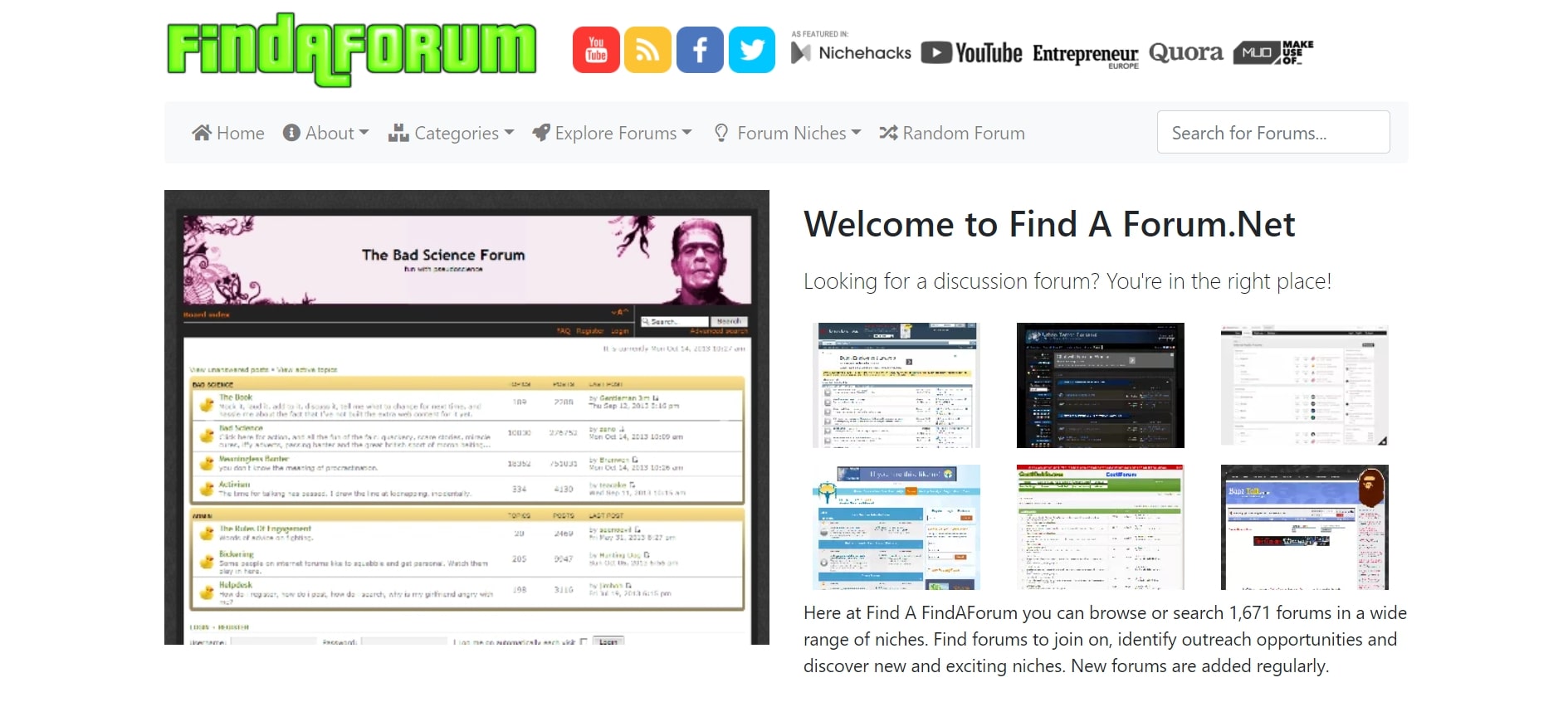
To discover a forum that matches your field faster, try using an internet resource like FindAForum. Simply go to its categories section or enter your niche in the search bar to find a list of discussion forums.
Here are some suggestions on how to promote your blog via online forums:
Participate - To develop trust and make people more willing to engage in a blog, be prepared to contribute to the forum regularly. Try to answer questions, provide quality responses, and link to helpful resources.
Start a thread - Another way to prove that you're a valuable member is to create your own threads. Begin by making a shorter and different version of your blog content and use it to start a new thread.
Create a signature - Some forums let users create a signature or a text that appears below a post or thread. Take advantage of this signature to make a call to action to bring traffic to your site.
10. Try reciprocal sharing sites
Bloggers can also use a reciprocal sharing site to promote their blog. Using this method, they need to share other users' content on their social media accounts to get their blog posts promoted.
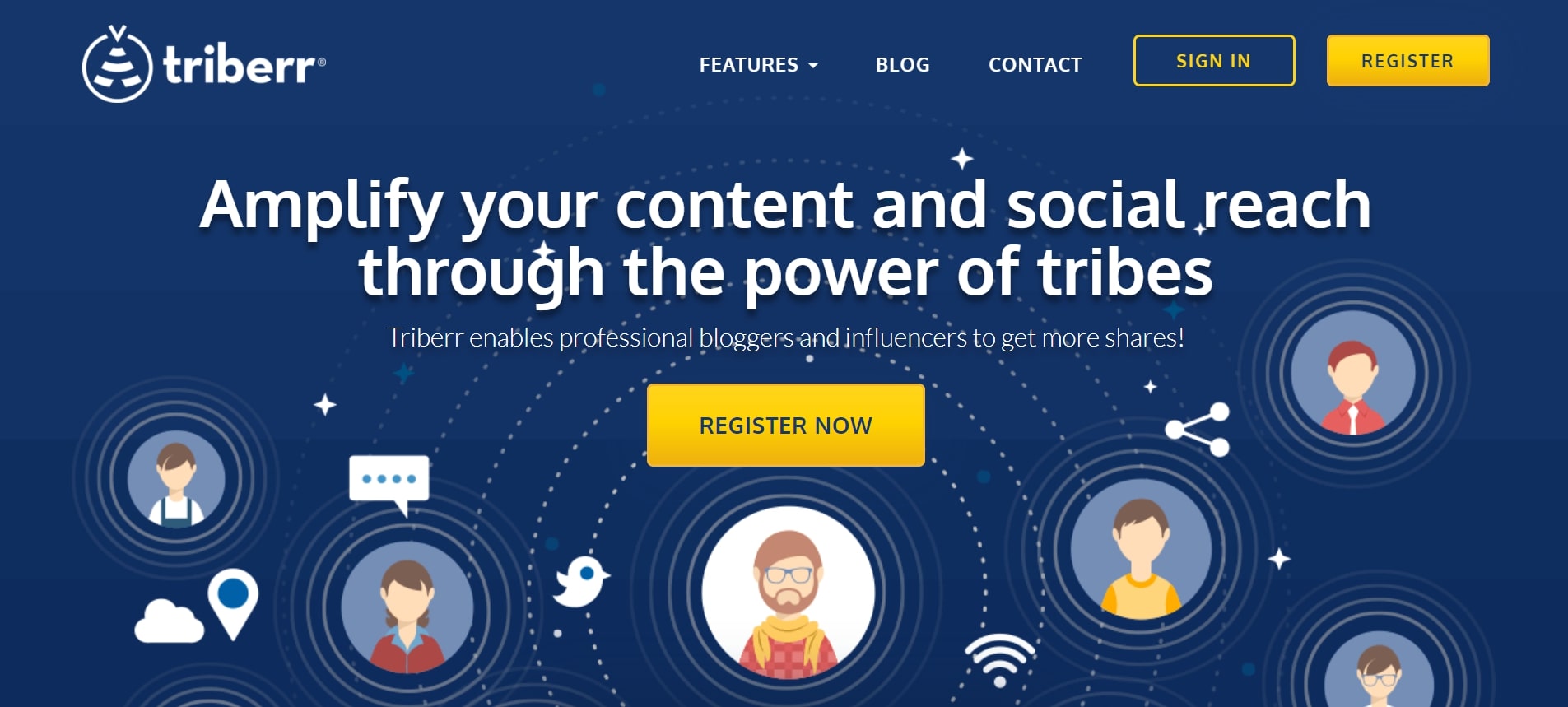
One of the most popular reciprocal sharing websites is Triberr. This tool makes it simple and easy to grow your audience, find great posts to share with readers, and network with other bloggers.
When using a reciprocal sharing site, make sure to share content that is editorial in line with the type of post you want to be known for curating – it helps increase your credibility and exposure in a specific niche.
Also, remember to include relevant images, graphics, or relevant stock photos to make your content stand out.
Another tip is to be consistent and make it a habit to regularly share posts or respond to comments. The more consistent you post and interact with other users, the more reliable you seem to be.

Promoting your blog
Aside from publishing awesome content, bloggers must also spend time and effort promoting their blogs. Without a promotion strategy, it can be difficult for a blog to grow and generate a steady stream of readers coming to check the site out.
The most effective strategy for you also depends on the resources at your disposal, such as the budget, skill set, and timeframe.
Here are ten strategies on how to promote your blog and get more qualified visitors:
- Utilize SEO for your blog
- Do proper keyword research
- Use email marketing
- Share your blog on social media
- Promote your blog with online paid advertising
- Guest post on popular blogs
- Reach out to other blogs
- Get your blog on social bookmarking sites
- Promote your blog in online forums
- Try reciprocal sharing sites
Keep in mind that it may take a few weeks or months before you notice a significant increase in your traffic and online ranking.
- Also check out our complete list of the best web hosting services
How To Promote A Free Wordpress Blog
Source: https://www.techradar.com/news/10-ways-to-promote-your-blog-in-2021
Posted by: santosandesell.blogspot.com

0 Response to "How To Promote A Free Wordpress Blog"
Post a Comment